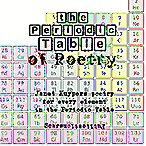



|
enjoy this writing from Janet Kuypers in the cc&d free 2013 PDF file chapbook: Poetry Saloon at Noon of edited poems from the first live feature 1/30/13 at the Chicago Cultural (select poems from the “Periodic Table of Poetry”). Click the title or the cover to download the free PDF file chapbook. |

|
|
Order this writing in the book Guilt by Association cc&d 2013 collection book |
 |
get the 374 page Jan. - June 2013 cc&d magazine issue collection 6" x 9" ISBN# paperback book: |
| ||
|
Order this writing in the poetry book by Janet Kuypers with poetry for every element in the Periodic Table: the Periodic Table of Poetry Order this 8.5" x 8.5" ISBN# book today: |

|
|
| |
|
Order this Janet Kuypers writing from her 2018 paperback book: “On the Edge” Order this 6" x 9" ISBN# book today of of editor Janet Kuypers’ poetry in cc&d issues 216-252, + in cc&d chapbooks |

|
|
| |
![]()




